The stunning landscapes of North Iceland captivate all who visit. Here, you'll discover awe-inspiring gorges like Kolugljúfur and Jökulsárgljúfur, and striking sea stacks such as Hvítserk and Stórakarl. Evidence of volcanic activity can be seen in Mývatnssveit, and Ásbyrgi, shaped by a glacial eruption thousands of years ago, is a must-see.
Numerous waterfalls grace the region, including Europe's most powerful waterfall, Dettifoss, the historic Goðafoss, and the picturesque Aldeyjarfoss.
Surrounded by majestic mountains, North Iceland offers a variety of hiking trails for mountaineers, allowing everyone to revel in its natural beauty
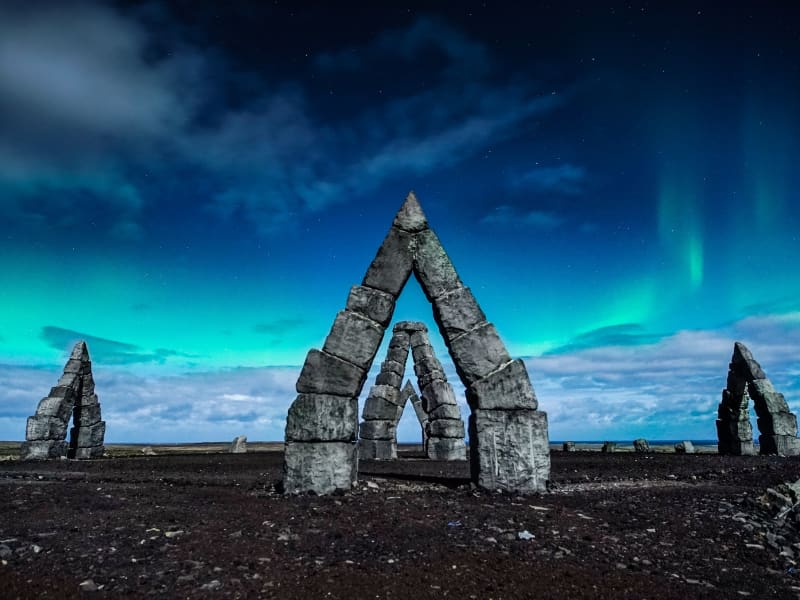
Arctic Henge
Set in Raufarhöfn, one of the most remote and northernmost villages in Iceland where the Arctic Circle lies just off the coast, the Arctic Henge (Heimskautsgerðið) is under construction. Similar to its ancient predecessor, Stonehenge, the Arctic Henge is like a huge sundial, aiming to capture the sunrays, cast shadows in precise locations and capture the light between aligned gateways.
History
Heimskautsgerðið (The Arctic-Henge) has it s roots in the innovators Erlingur Thoroddsen’s speculations about the possibility to use endless vistas, where nothing obstructs the horizon, and the midnight sun. The idea to use the dwarf names from the eddic poem Völuspá (Prophecy of the Seeress) and modernize some aspects of the old world of the Sagas, soon became a part of these speculations. The first version of the idea is from 1998 but in 2004 it was finalized, with allusions to mythology and folklore, designed to interact with the unique natural light. The designer of the project is Haukur Halldórsson.
No one has been able to explain the dwarfs in the Völuspá, apart from Austri (East), Vestri (West), Norðri (North) and Suðri (South), who carry the sky. By connecting the names of the dwarfs to the season, as for example Bjartur (Bright) Blíður (Sweet) and Svásuður (Gengle) to the summer, it is possible to fit the names of the dwarfs to a yearly circle of 72 weeks. The year-circle of the dwarfs becomes a kind of almanac, where each dwarf controls a five day period. All the dwarfs have been given a role and they have all have their own personalities. This means that the dwarfs can be connected to birthdays and people can connect to their personal dwarf.
Around this made up world rises the Heimskautsgerði (Arctic-Henge) on the Melrakkaás (Foxhill) in Raufarhöfn. The Heimskautsgerði is around 50 meters in diameter, with 6 meter high gates that face the main directions. Between the gates is a high wall with a small opening at the top. Inside the circle stands 10 meter high column on four pillars. The column will be topped with cut prism-glass that splits up the sunlight unto the primary colors. The opening between the pillar look towards the main directions, so example the midnight sun can be seen from the south gate through the middle column and the north gate. The play of light and shadow will follow the time of the day. The openings on the wall will let in the sunrays so when the building is completed a sundial can be set up.
Inside the circle are 68 dwarfs who stand around a circular dwarf trail. Inside the trail is the polar star pointer, and does exactly what its name says. There you can also find the throne of the sun that is meant to be a place where the traveler can sit down to have his picture taken. Also a hall of rays, which is a sort of sanctuary between high columns, with one seat, where the guest can empty his mind an renew his energy. An altar of fire and water, reminds us of the power of the elements, where events can be performed, for example weddings, oath-taking and so forth.
More information available at www.arctichenge.com
Getting There
It´s about 130 km from Húsavík, but good roads all the way, so allow 1.5 hrs.Follow the road 85 northeast out of Húsavík, past Ásbyrgi, taking the 874 road junction east just before Kópasker. Once in Raufarhöfn, you can´t miss the stones, looming impressively on the hill above the town. There is a short track to drive up, or you can walk if you prefer. Here is the route.
View
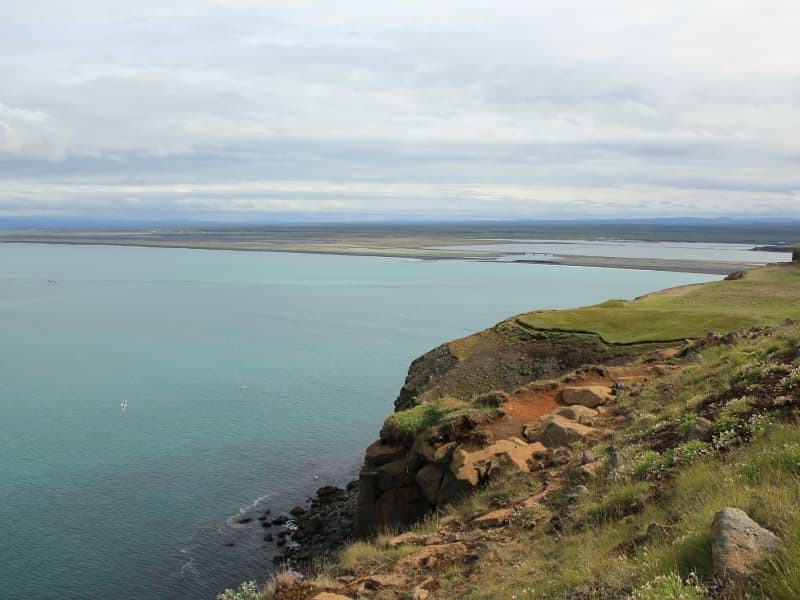
Hringsbjarg Cliff
From Hringsbjarg cliff you have a breath-taking view over the mountain range in Öxarfjörður fjord and the black sand beach close by.
This place is the perfect place to stop and stretch your legs, breathe in the fresh sea air and enjoy the view and tranquillity.
At Hringsbjarg cliff is an observation deck as well as tables and information signs.
Great birdlife.
View
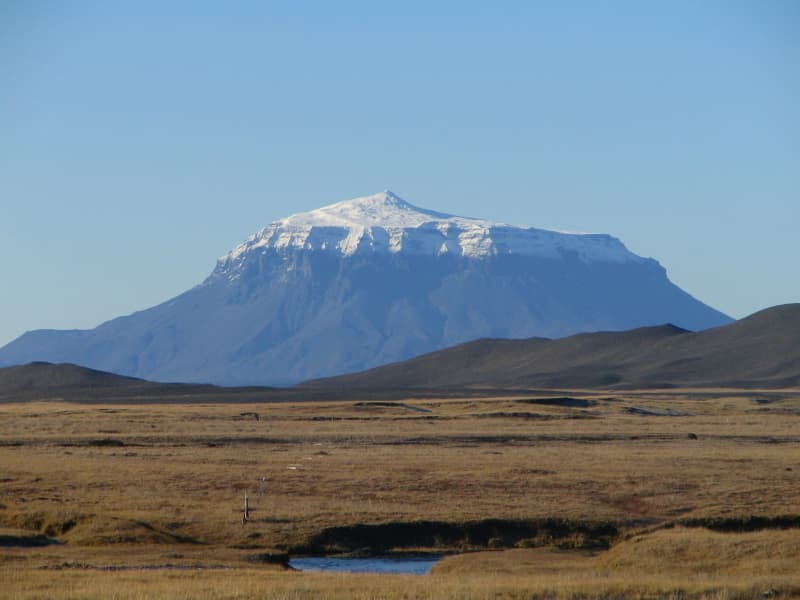
Möðrudalur
At an altitude of 469 m, Möðrudalur farm lies higher than any other Icelandic farm. The remarkable, tiny church was built by the farmer himself, Jón Stefánsson, in 1949. The tourist services here operate year-round. Various trails have been marked through the area, which prides itself on wide panoramas and amazing silence. The majestic Mount Herðubreið, looming in the near distance, has long been referred to as the Queen of Icelandic Mountains, but its image was further cultivated in the last century by a self-made painter from Möðrudalur farm, Stefán Jónsson (Stórval).
View
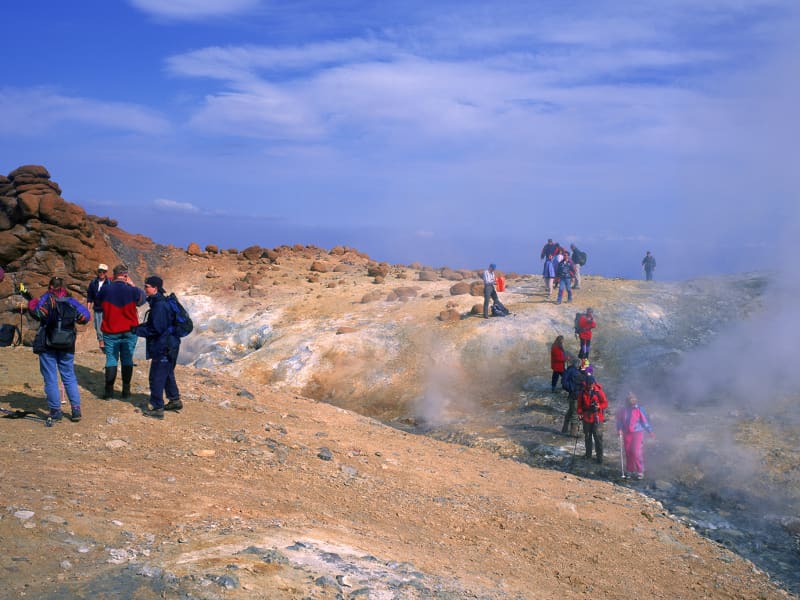
Kverkfjöll
The Kverkfjöll mountain range, Iceland's third highest mountain group, is a cluster of peaks formed by a large central volcano on the northern edge of the ice cap.One of Iceland's most active high-temperature geothermal areas is located in the western Kverkfjöll Mountains. Its existence is due to a fault scarp. An area of hot springs 3 km long and nearly 1km wide can be found at an altitude of 1600-1700 m.
More information about the National Park is at the webpage: www.vatnajokullnationalpark.is
View
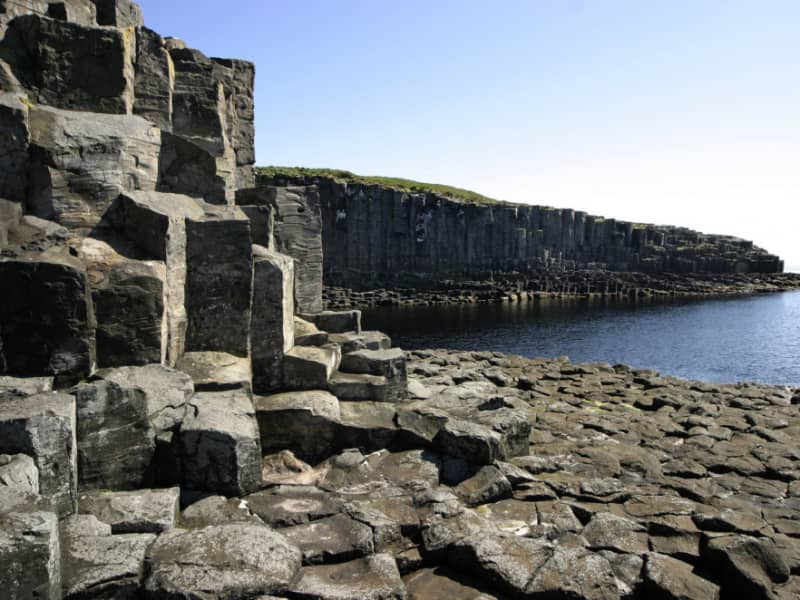
Grímsey Basalt Columns
The size of the columns depends on the rate of cooling; very rapid cooling may result in very small columns, while somewhat slower cooling is more likely to produce large columns.
View
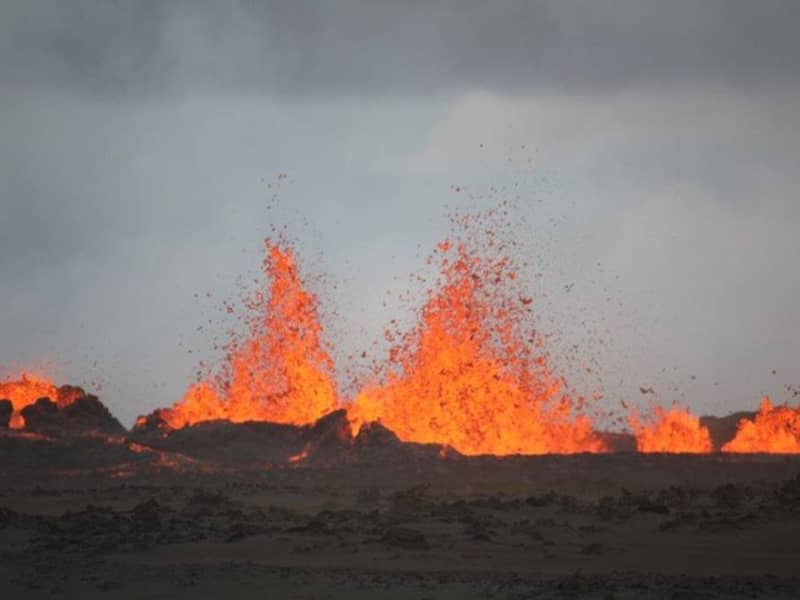
Bárðarbunga
Bárðarbunga, is a stratovolcano located under Vatnajökull, Iceland's most extensive glacier. The second highest mountain in Iceland, 2,009 metres (6,591 ft) above sea level, Bárðarbunga is also part of a volcanic system that is approximately 200 kilometres (120 mi) long and 25 kilometres (16 mi) wide.
View
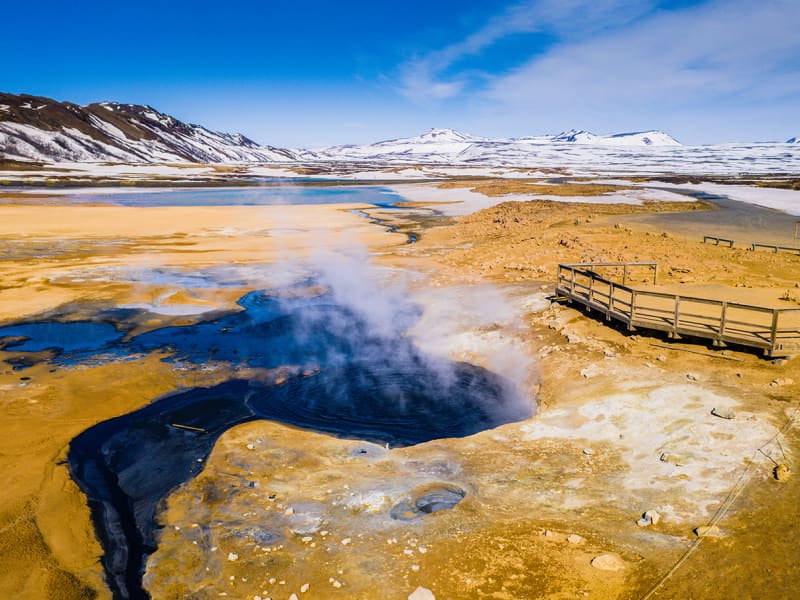
Námafjall
At the foothills of this spectacular volcanic mountain is an expanse of hot springs called Hverir that are known for their variety. You will also discover fumaroles, mud pools and mud pots that all seem to be boil with relentless energy. The pass Námaskarð is strategically located at a short distance from the Krafla volcano system as well as other interesting geological spots like Búrfellshraun lava field and the desert Mývatnsöræfi.
Námaskarð earns its notoriety chiefly because of its sulphurous mud springs called solfataras and steam springs called fumaroles. Though you will scarcely find any pure water spring in this wonderful geothermal site of Iceland, the beauty of the colourful minerals defies all comparison. The gigantic size of the mud craters is what makes you go 'wow' at the sight of them.
The other thing that is sure to strike you about Námaskarð is the sheer lack of vegetation. The constant emission of the fumes has made the ground utterly sterile and acidic, unfit to sustain any floras and faunas. You must bear in mind that the fumes can be harmful for humans as well.
View
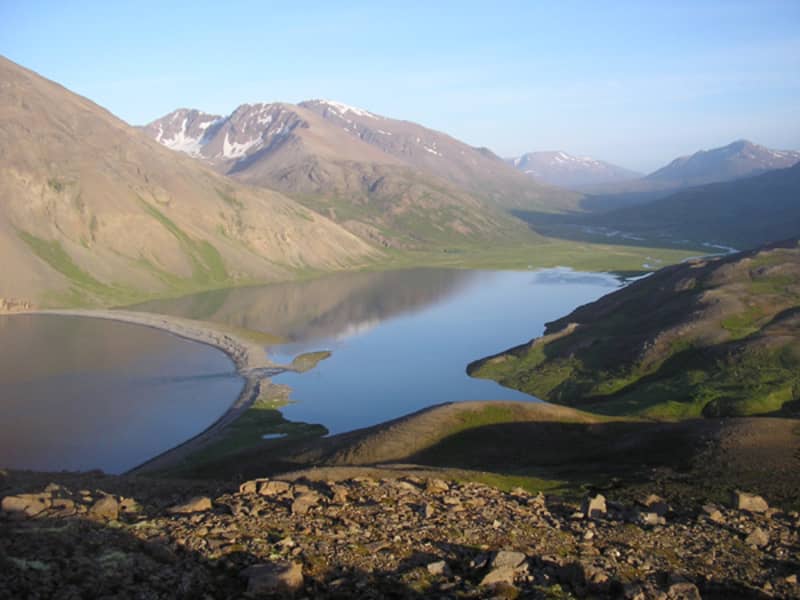
Fjörður
The peninsula between Eyjafjordur and Skjalfandi Bay is a paradise for hikers. Two 4WD tracks lead to the north of the peninsula, one to Hvalvatnsfjordur and the other to Flateyjardalur. No services, but camping allowed in specific areas.
View
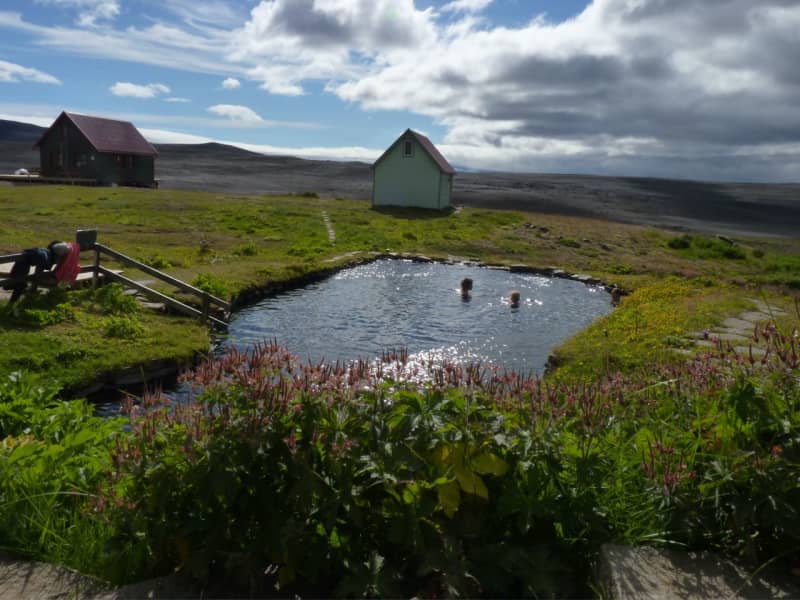
Laugafell
An oasis in the barren land between the glacier Hofsjokull and Vatnajokull. The site is about 25km to the west of the best known highland route “Sprengisandur”. On the north-western slopes of the mountain Laugafell, there are geothermal hot springs bubbling and three mountain huts open in summer, with kitchen facilities and a nice geothermal nature pool outside.
View
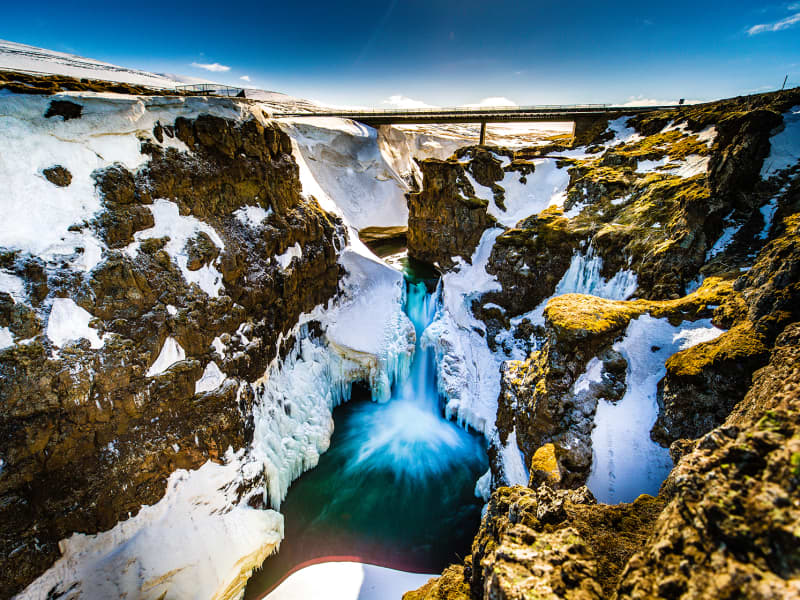
Kolugjúfur
As you drive along Víðidalur, you will come to Kolugil Farm which stands beside the Víðidalsá river. Just below the farm, the waters flow peacefully downwards to plunge into the deep, rugged gorge called Kolugljúfur. Their journey then sends them cascading over many waterfalls which bear the name Kolufossar Falls in honour of the giantess, Kola.
It is a breathtaking sight to walk on the the viewing platform and watch the calm waters of the river suddenly leap and tumble onwards over so many impressive falls – a sight which will leave no one unmoved.
View
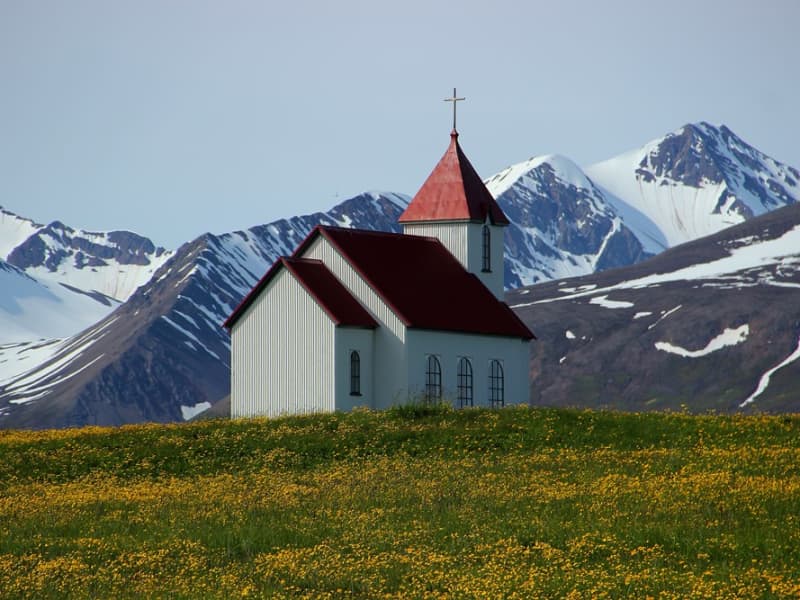
Flatey Island
Flatey is a beautiful island and an unforgettable experience to visit. You have the feeling time stops here or even goes back in history. Many residents in Húsavík have houses on Flatey, which though uninhabited since 1968, was once a lively village with a church, a schoolhouse, and a lighthouse. Residents slowly left once electricity began to arrive on the mainland. Spread flat, the island is rich in bird fauna, with over 30 different types of bird to watch, including among others Arctic Tern and the Puffins.
View
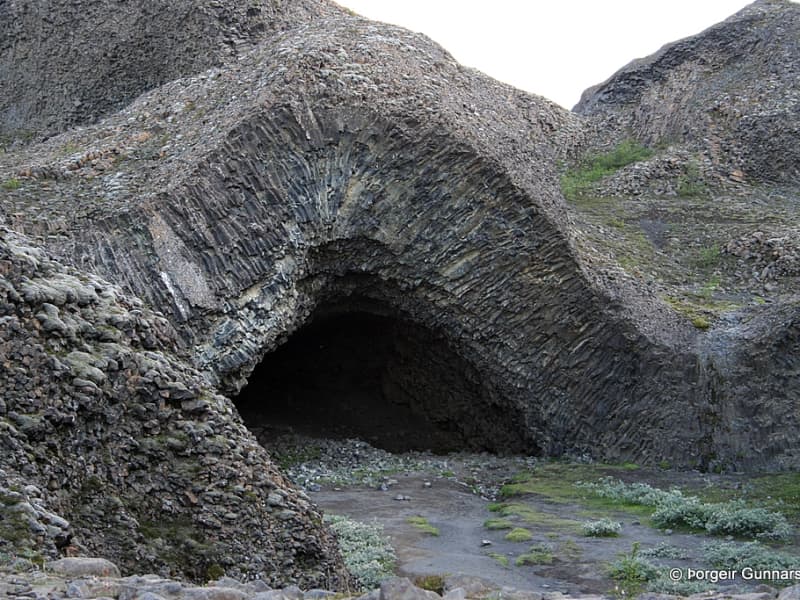
Hljóðaklettar
Hljóðaklettar in the canyon Jökulsárgljúfur is a distinctive cluster of columnar rock formations standing at the entrance to Vesturdalur, down by the Jökulsá á Fjöllum River. The columns lie at all angles and it’s an entertaining exercise for one's imagination to interpret their patterns.
The road to Hljóðaklettar (862) is closed over the winter months.
View
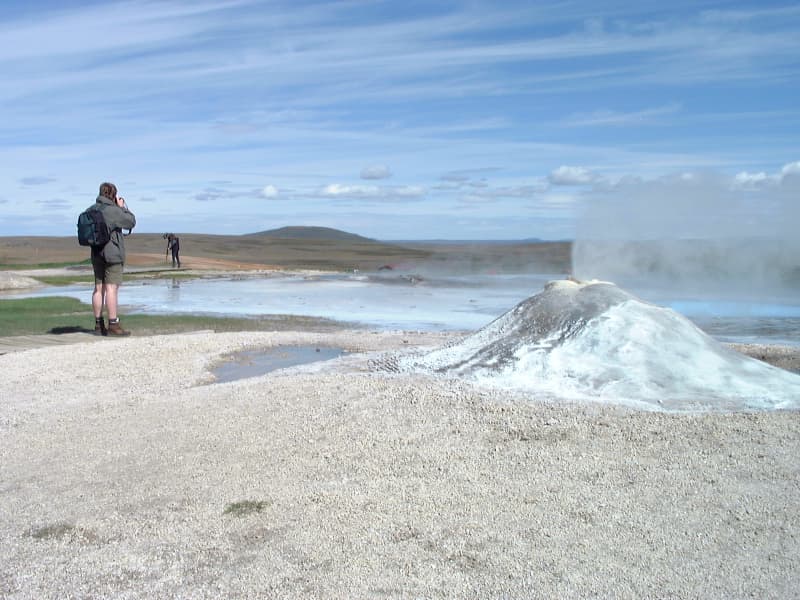
Hveravellir
The “hub” of the Kjolur Route, is a geothermal area of fumaroles, and multicoloured hot pools. There are two mountain huts with kitchen facilities and a nice hot pool just outside the hut.
View
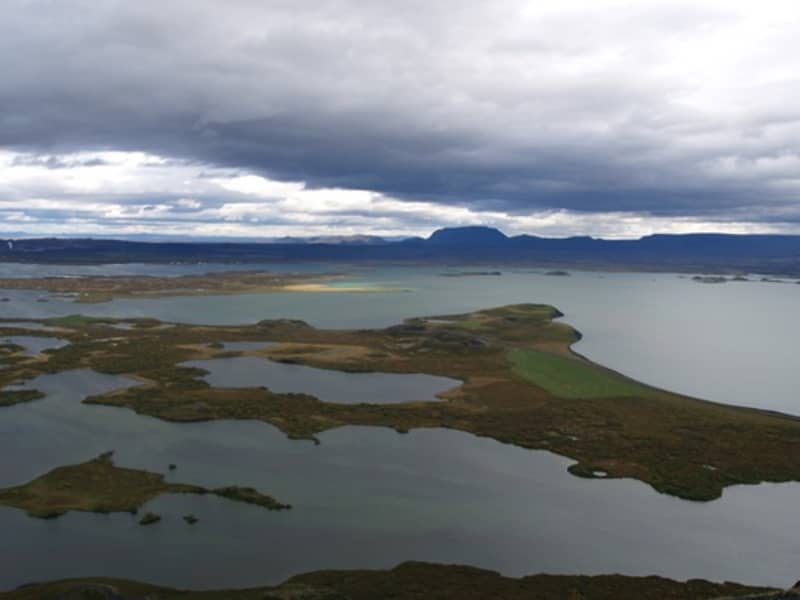
Skútustaðagígar
Skútustaðagígar pseudo craters were formed by gas explosions, when boiling lava flowed over the wetlands. The craters are a popular site for birdwatchers and are protected as a natural wetland conservation area.
View
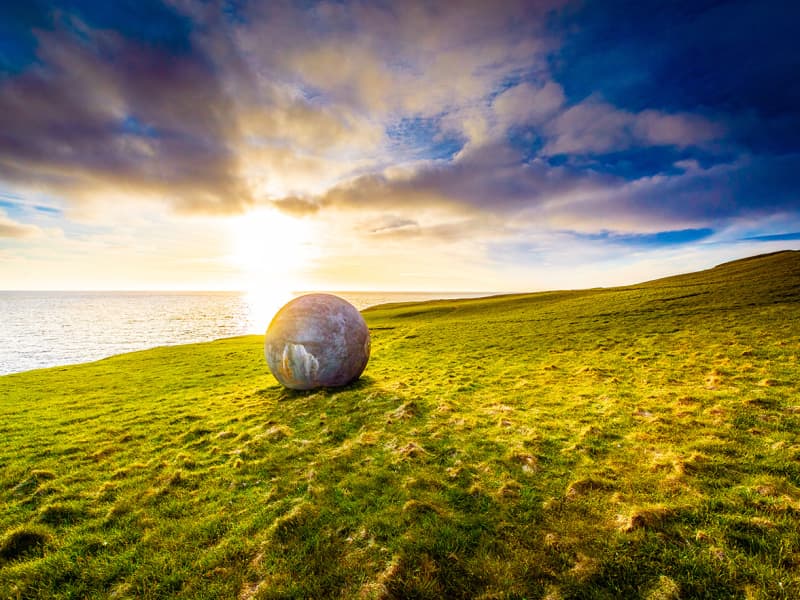
Orbis et Globus
The artwork "Orbis et Globus" was inaugurated on the Arctic Circle in Grímsey Island in the fall of 2017. It is a 3-meter sphere which is meant to be moved around the north end of the island in accordance with the movement of the Arctic Circle.Before the 2018 Summer Solstice Festival in Grímsey, the artwork was moved about 130 meters to the south, and this year it will be moved approx. 69 meters.The artwork is a symbol and a landmark for the Arctic Circle and has attracted attention from all over the world. The aim of the project was to draw attention to this northern most part of Iceland and to increase attractiveness of the island for tourists. Already, this has happened with great success. The inhabitants of Grímsey are less than 100 people and it is of the utmost importance to strengthen residence there all year round.Most visitors that come to Grímsey now, aim to reach "the sphere of the north". They want to see and touch the artwork and while doing so step beyond the Arctic Circle.The walk from the harbour to the artwork is about 3.7 km and from the airport about 2.5 km. One must expect about 3 hours walk forth and back. It is recommended to stay overnight as the traditional stop of the ferry and the air plain is almost too short to enjoy and see the most essential things on the island. Things one should try to do while on the island is to walk around in the little village, drop by the Fiske-monument and read the sign-boards, visit the restaurant Krían (Arctic tern) and/or the smallest Café in Iceland at the Guesthouse Gullsól. Take a walk to the lighthouse at the islands southernmost point and walk along the south-west shore of the island and look at the beautiful basalt columns and old fishing huts. On that route one can find the "Century stones" which display the position of the arctic circle Anno 1717, 1817 and 1917. During the birding season (end April till beginning August) one must also calculate some time for bird-watching as that's one of the phenomenal things experiencing in Grímsey.Orbis et Globus was designed by the artists Kristinn E. Hrafnsson in collaboration with Studio Grandi. It was selected to be the new landmark for the Arctic Circle in a competition for such an artwork held in 2013.
View
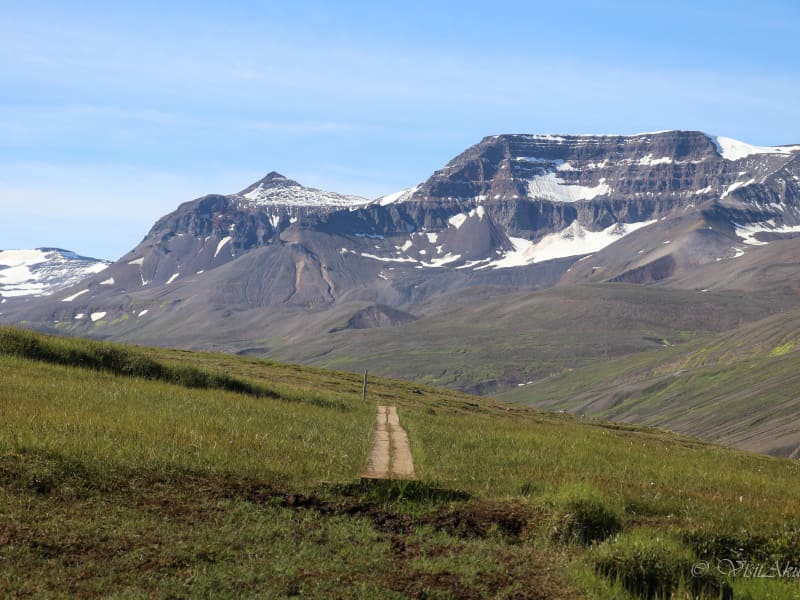
Glerárdalur Valley
A nice walk leads from the mouth of the valley Glerárdalur to the bottom of it and ends by the mountain cabin named Lambi, some 11 km into the valley.
View
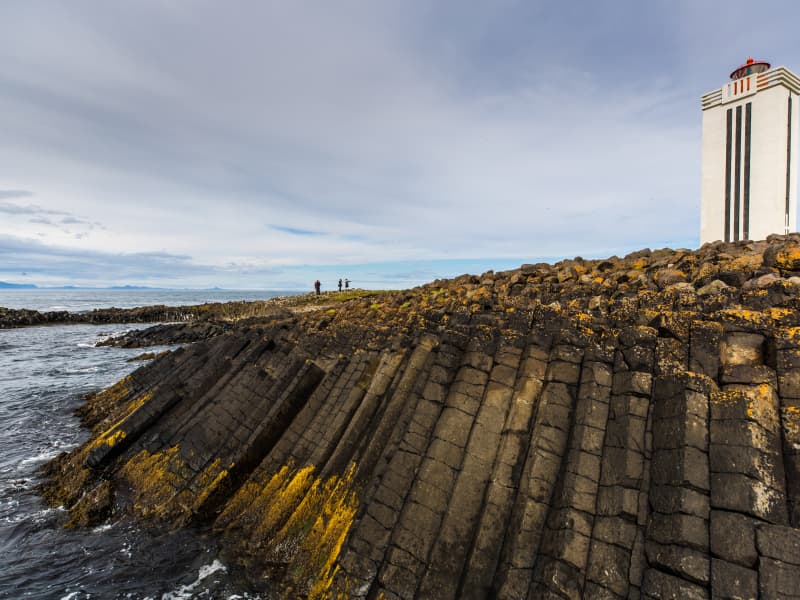
Kálfshamarsvík
Kálfshamarsvík is a small cove in the northern part of Skagi, with unusual, beautifully formed sea cliffs of columnar rock, created about 2 million years ago. At the beginning of the 20th century, fishing boats plied the waters and there was a small community of about 100 inhabitants at Kálfshamarsvík. However, by around 1940 the village had become deserted.
View

Jökulsárgljúfur Canyon
This dramatic canyon, Jökulsárgljúfur, was formed by the actions of water, fire and ice. Enormous, catastrophic glacial bursts are believed to have carved out the deep ravines and rocky basins, the most famous of which is Ásbyrgi.The Hljóðaklettar outcrops are the cores of ancient volcanoes, revealed when the river swept away all the loose volcanic material.The waterfalls on the River Jökulsá á Fjöllum, Selfoss, Dettifoss, Hafragilsfoss and Réttarfoss are powerful and impressive.The Hólmatungur district is an area of contrasts: crystal clear streams and bubbling brooks cross the land before emptying into the raging, chocolate-coloured torrent. A delicate balance of flora and fauna thrives under the protection of cliffs and scree slopes.
View
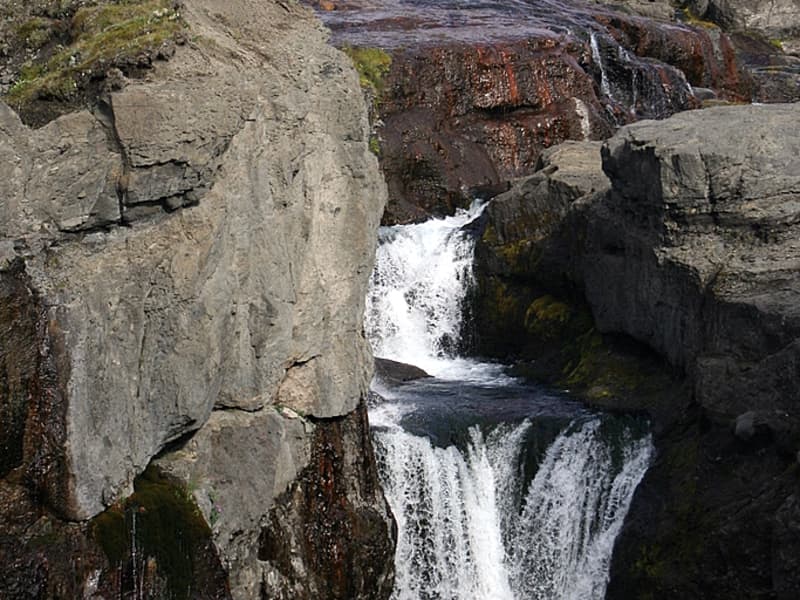
Hólmatungur
Hólmatungur is an expanse of rich vegetation in the Jökulsárgljúfur area, and there are many beautiful columnar rock formations to be found there.
The footpath between Hljóðaklettar and Hólmatungur, alongside Jökulsá á Fjöllum, is among the most beautiful in Iceland. The waters of countless streams bubble up in Hólmatungur, which then tumble over ledges into Jökla. Here you will also find Gloppuhellir cave in Gloppa, which is a very special natural creation.
View
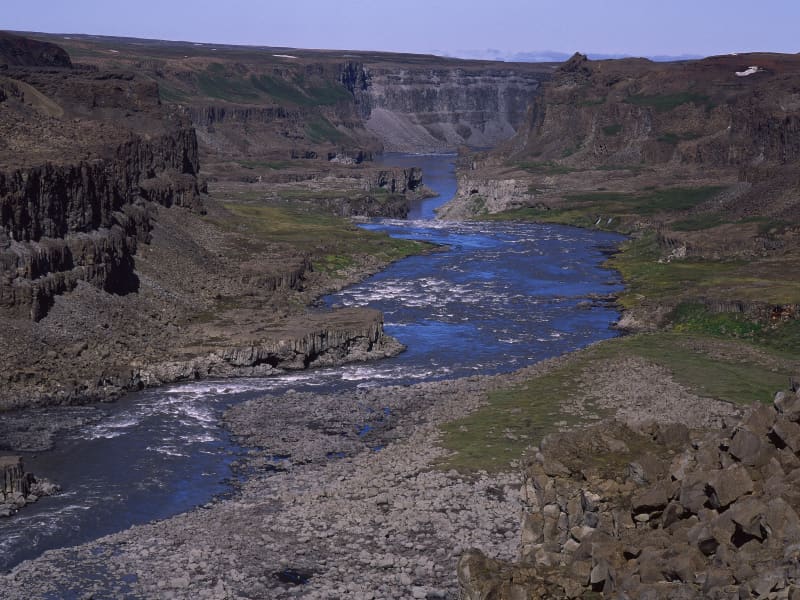
Vatnajökull National Park - north part
Vatnajökull National Park is vast in size and covers more than 13% of Iceland. Despite a large part of the national park being underneath the icecap of the glacier Vatnajökull its landscape is diverse, predominantly due to the interplay of volcanic activity and glaciers.
Jökulsárgljúfur is an area that takes its name from a canyon carved out by river Jökulsá á Fjöllum. Within this area is Ásbyrgi; surrounded by horseshoe-shaped cliffs and also the location of Ásbyrgi visitor centre and a large camp site. Also within Jökulsárgljúfur are waterfall Dettifoss and crater plugs Hljóðaklettar, both a must see for every visitor in the north.
Central volcano Askja and highland oasis Herðubreiðarlindir are further up in the highlands. To get there requires a 4x4 transport. They are best accessed by road 901 and then F905. Two small fords need to be crossed on this way. Alternative route is through road F88 but then two fords that need extreme caution need to be crossed. More information about the National park is at the webpage: www.vatnajokullnationalpark.is
View
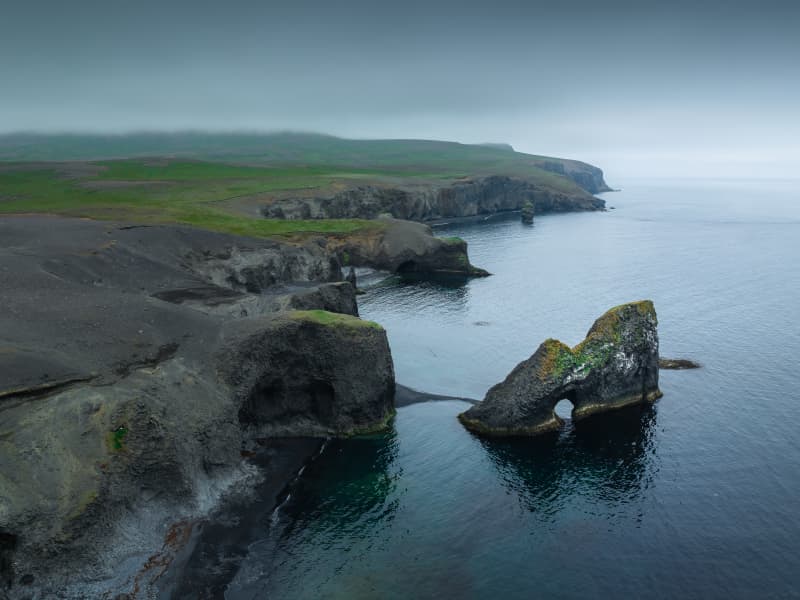
Hestfall, Hvalsvík Rock Formations
The gravel road No.870 leads to the peninsula Melrakkaslétta and a short drive north of Kópasker lays a parking area well marked with painted stones. Drop-off your car and take a short walk straight down to the rock formation Hestfall - but be careful as the steep cliff is cut in two pieces by a vertical fissure! On your way back walk to the shore south of the parking and you see the beautiful rocks of Hvalvík in the ocean. Please don´t try to access the beach, the waves are dangerous!
Please note this is a summer destination.
View
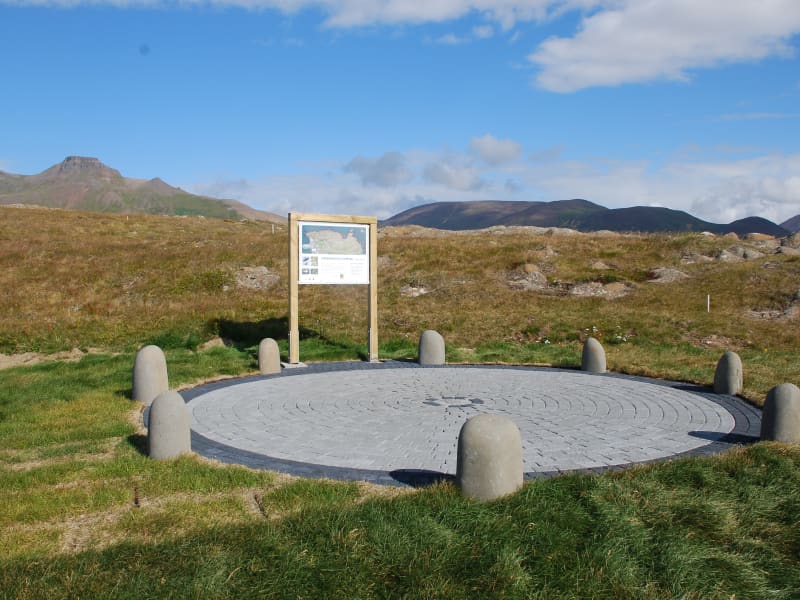
Spákonufellshöfði Headland
Spákonufellshöfði headland is popular among those interested in walking and other outdoor recreations, and is a short way from the harbour in Skagaströnd.
Marked footpaths have been laid out and signboards erected telling the visitor about the area’s flora and fauna. On a bright, clear summer evening, one can witness the setting of the midnight sun as it dips to touch the horizon in the north. Indeed, the inhabitants of the area make use of the headland all year round and enjoy all that it has to offer.
View
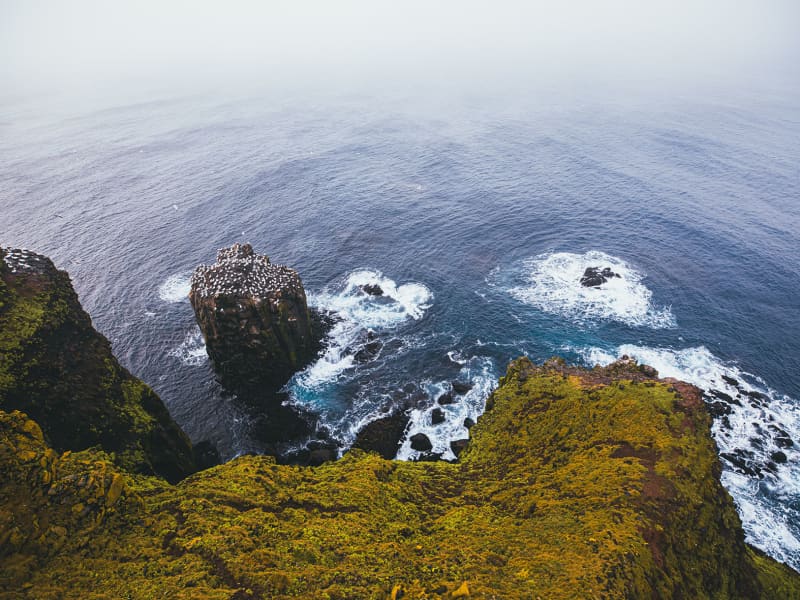
Stórikarl
Langanes is a veritable outdoor paradise teeming with birdlife, great for nature study and hiking.
Skoruvíkurbjarg, located mid-way out on its northern shore, is a great place to view and photograph sea birds such as auks. A viewing platform extending some 10m out from the cliff offers a close range view of a colony of the magnificent Northern Gannets on the sea stack Stórikarl. It´s Iceland’s second largest Gannet colony, while nearby are colonies of auks, including guillemots and puffins in the bird-filled cliffs at Skoruvíkurbjarg.
The Gannet is the largest seabird in the North Atlantic and has earned the nickname Queen of the Atlantic.
Langanes peninsula is a treat for birdwatchers.
View
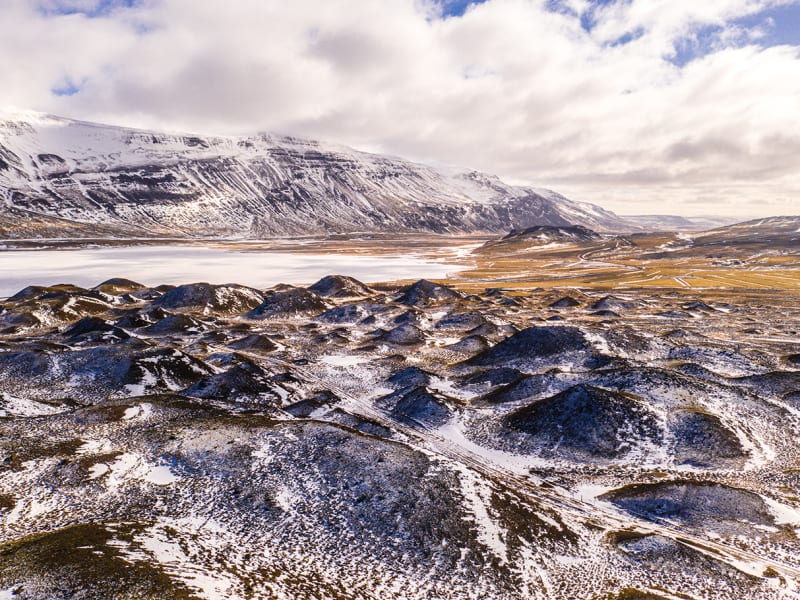
Vatnsdalshólar
Vatnsdalshólar are a cluster of hills of all sizes across the mouth of Vatnsdalur valley. Thought to have been formed by a catastrophic landslide. These hills are considered to be one of the three “innumerables” things in Iceland along with the lakes in Arnarvatnsheidi and the islands on Breidarfjord in the west.
View

Skúlahóll
Skúlahóll is one of the hills in of the cluster Vatnsdalshólar in Vatnsdalur Valley. From the hill is a beautiful view over the lake Flodid, which was formed in a landslide from the mountain across the valley in 1720.
View
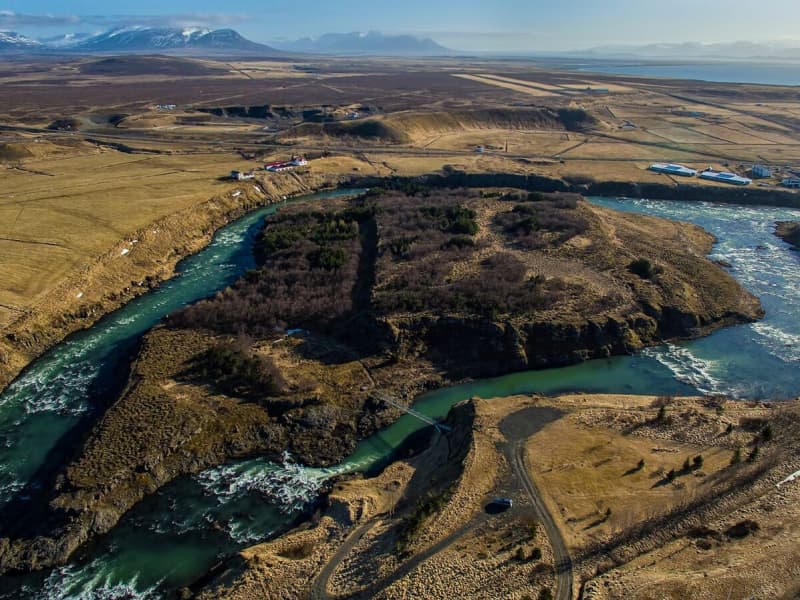
Hrútey
Hrútey Island is the real feather in the cap of Blönduós town, which is almost encircled by the river Blanda. Hrútey is blessed with a wide variety of vegetation and birdlife is abundant, being the habitat of geese and many other species. It is easily accessible and lies just off Highway 1.
There is a good parking area by the river bank and a trusty pedestrian bridge over to the island. Hrútey is an excellent place for outdoor exercise, or just to stop and take a break. There are good footpaths and a clearing with benches and picnic tables.
View
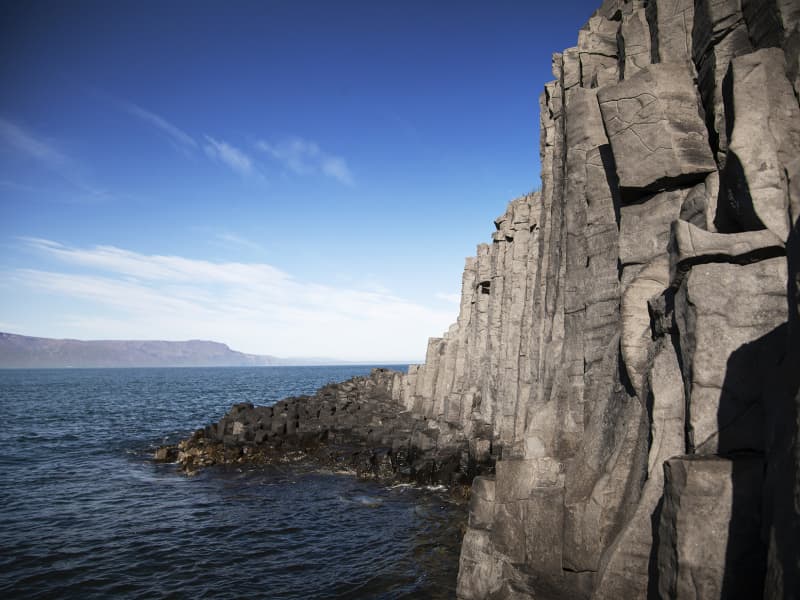
Staðarbjargavík
Not to be missed on the coast just below Hofsós are the amazing basalt formations at Staðarbjargavík. It is said to have been the capital of the Skagafjörður elf population. Good access to the area is from just below The Hofsós Swimming Pool.
View
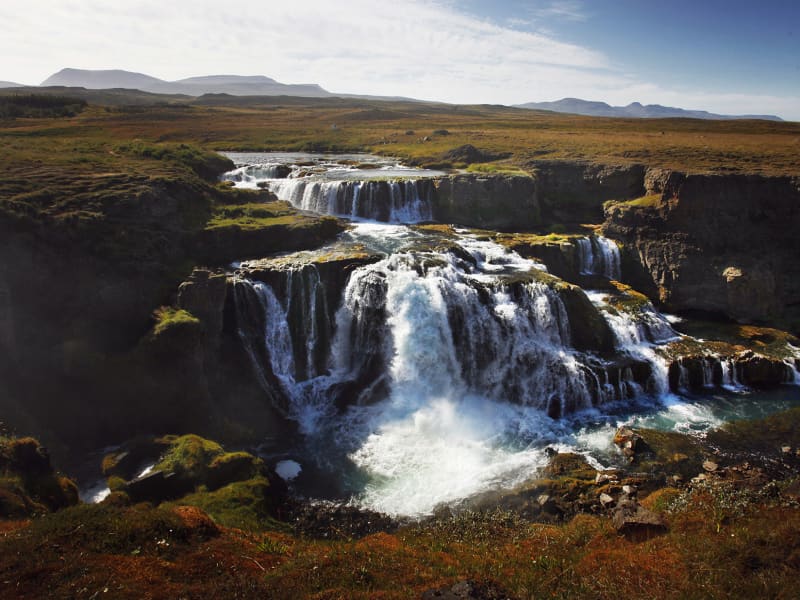
Reykjafoss
Reykjafoss waterfall is one of Skagafjörður's hidden treasures. It is the most beautiful waterfalls in Skagafjörður, located about 7 km from Varmahlíð at Vindheimamelar, along road 752.
Directions to Reykjafoss:
Reykjafoss is located about 7 kilometers south east of Varmahlíð. Off road nr. 1 turn to road nr. 752 and then turn to road nr. 753. Cross the bridge, then turn right and reach a small parking lot. Reykjafoss is about 5-minute walk from the parking lot.
View
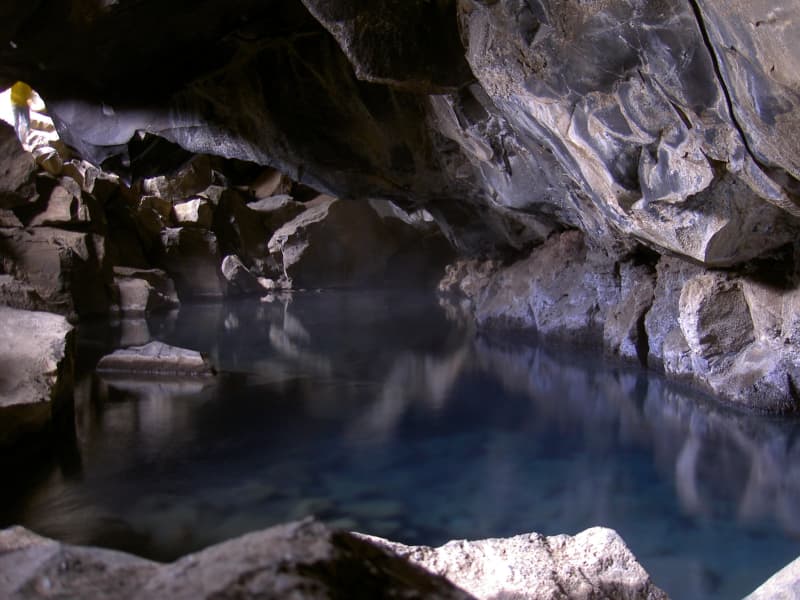
Grjótagjá
Grjótagjá is a small cave in the Lake Mývatn area, and was a popular bathing place at one time. However, geological activity in the period 1975-1984, caused the temperature of the water to rise to such a degree that it has not been possible to bathe there since. But one can always dream ... a peep into the waters and a fertile imagination can conjure up visions of taking a dip in this cosy little cave, as was the custom in the past.
View
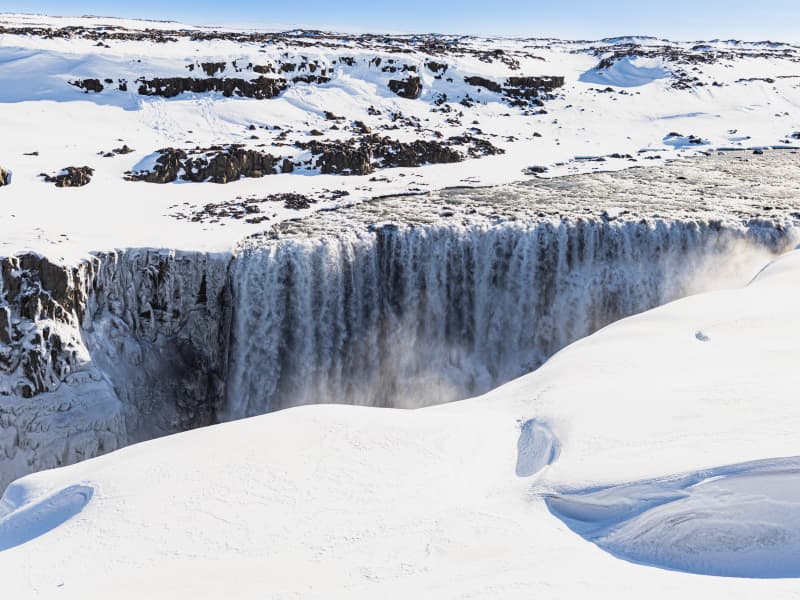
Dettifoss Waterfall
The Dettifoss waterfall is the most powerful waterfall in Europe, 200 cubic meters of water per second plunge over the edge. Dettifoss is 45 m high and 100m wide. A nice hiking trail, 34km, goes along the canyon from Dettifoss to Asbyrgi. Camping is possible in Vesturdalur.
Road 864 goes from road 85 past Dettifoss on the east side towards road 1. This is a gravel road and driving speed depends on road conditions each time. Road 864 is closed during wintertime due to snow or wet conditions (muddy road) and does not open until early summer (end of May).
Road 862 is on the west side of the waterfall. This road is paved but is not in winter service from January until the beginning of April. Dettifoss Waterfall is part of the Diamond Circle.
View
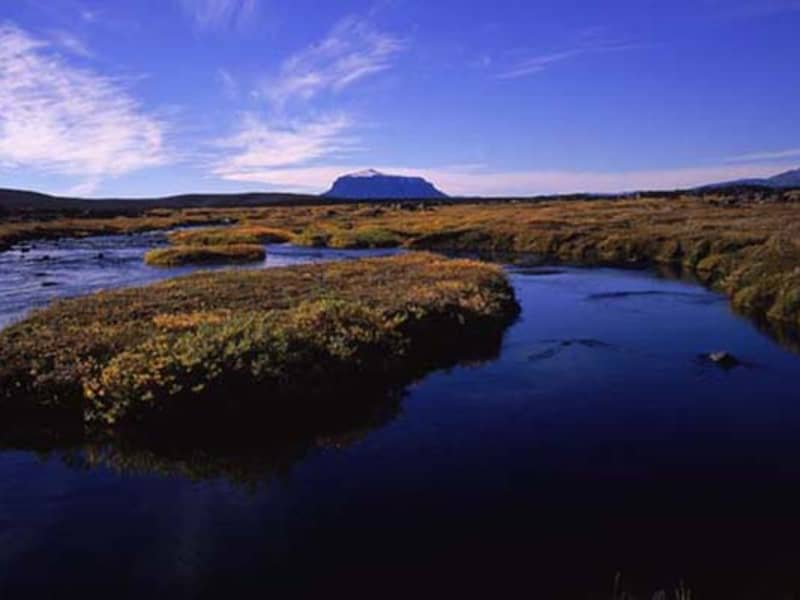
Herðubreiðarlindir
At the foot of Herðubreið are the Herðubreiðarlindir Springs, a spot with magnificent views and diverse natural attributes – which is probably why so many people consider this to be one of the most beautiful places in the country’s wilderness. The road to Herðubreiðarlindir is only passable in summer.
View
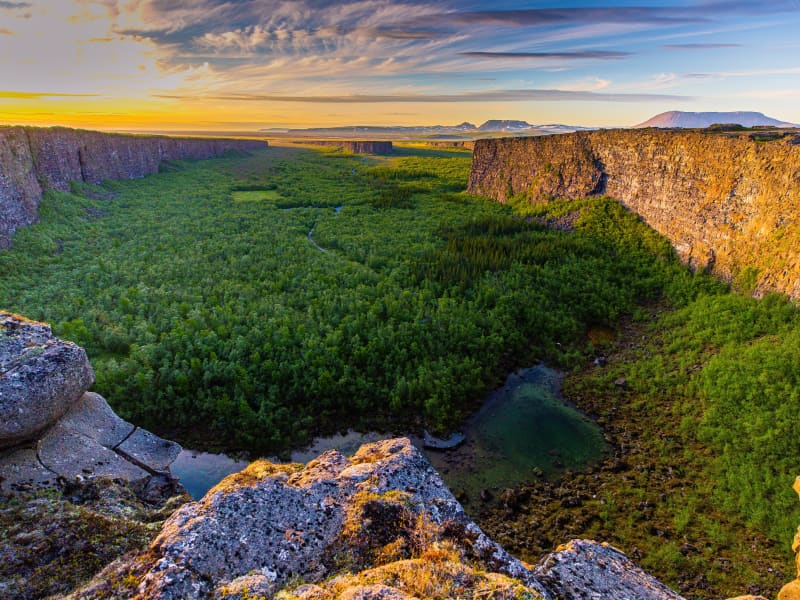
Ásbyrgi canyon
Ásbyrgi is one of the wonders of nature, a well-forested horse-shoe-shaped canyon in Öxarfjörður. Ásbyrgi is a part of Jökulsárgljúfur canyon, within the Vatnajökull National Park. The Jökulsárgljúfur site of the National park reaches from highway 85, by Ásbyrgi south to Dettifoss, covering an area of 120 km2. Informative visitor‘s centre, shop, golf course, and camping site are located by Ásbyrgi. Many hiking tracks are in the vicinity of Ásbyrgi. Ásbyrgi canyon is part of the Diamond Circle. https://www.northiceland.is/diamondcircle.
View
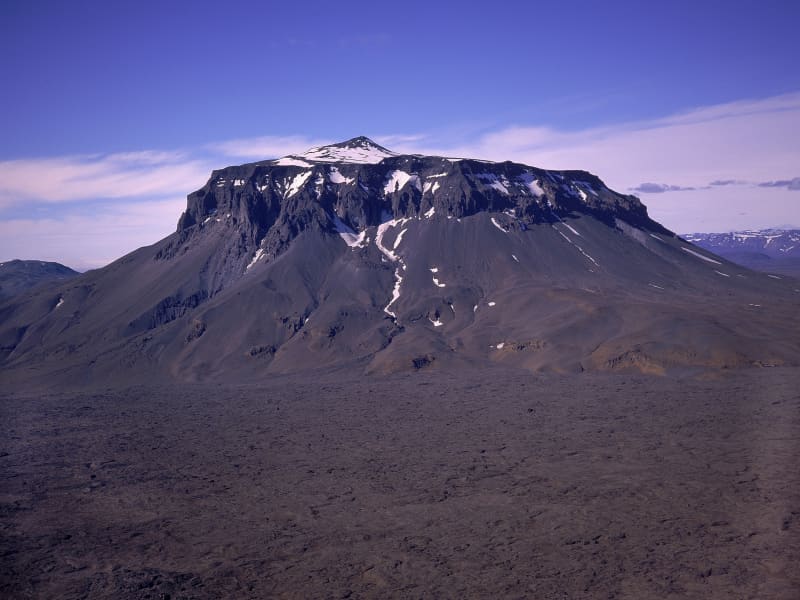
Herðubreið
Mt. Herdubreid on the Oskjuleið Route is a 1682m high table mountain. It is the national mountain of Iceland and often called the “Queen of Icelandic mountains”. There is a hiking trail to the top of the mountain, but due to loose rock it´s difficult and steep.
View
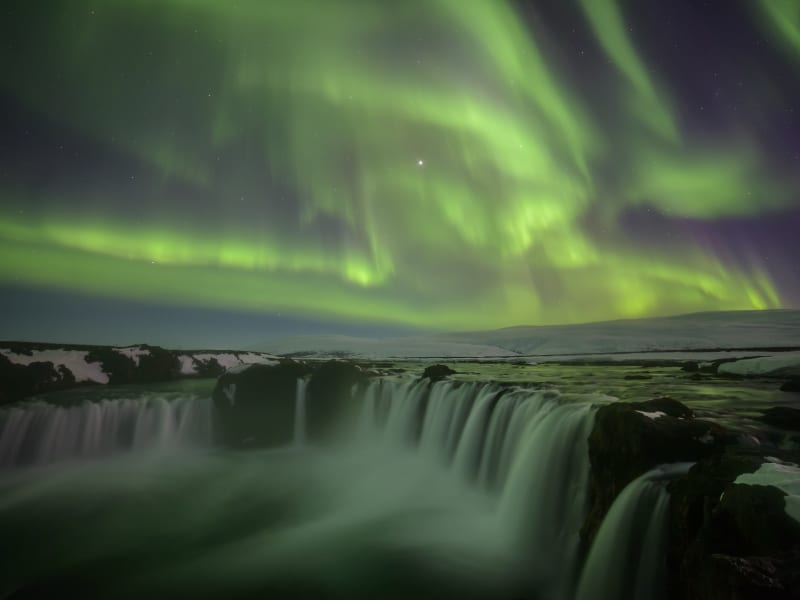
Goðafoss waterfall
The Goðafoss waterfall is one of the most spectacular waterfalls in Iceland. The water of the river Skjálfandafljót falls from a height of 12 meters over a width of 30 meters. The ring road goes past the waterfall, with parking available on both sides of the river and paved walking paths to viewing platforms.
The history of the waterfall is connected to the conversion of Icelanders to Christianity. Þorgeir Ljósvetningagoði, the country's law speaker, decided that the official religion of the country should be Christianity as pressure grew from other European countries with Norwegians at the forefront. The original Icelandic settlers were mostly Norwegians, and in order to keep the peace, Þorgeir took the decision of conversion.
Afterwards, he threw his idols of the Old Norse religion gods into the waterfall. The Icelandic word for gods is goð, and so the waterfall has been called Goðafoss ever since.Goðafoss is part of the Diamond Circle.
https://www.northiceland.is/diamondcircle
View
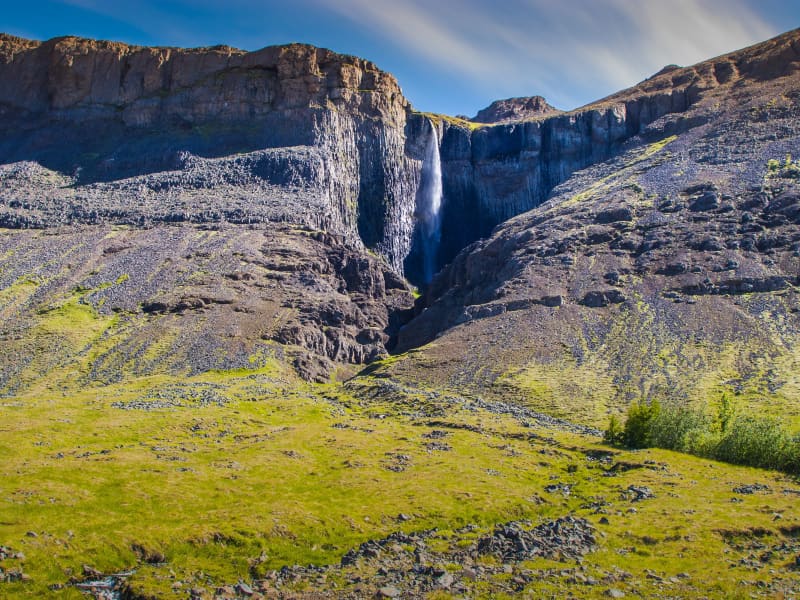
Hvammsfoss Waterfall
Waterfall Hvammsfoss is a rarely visited beautiful waterfall in Vatnsdalur Valley. It takes only 5 minutes to drive from Ring Road 1, so it's a perfect occasion to stop. Stretch your legs and take a short hike to experience the waterfall from very high baltic columns.
View
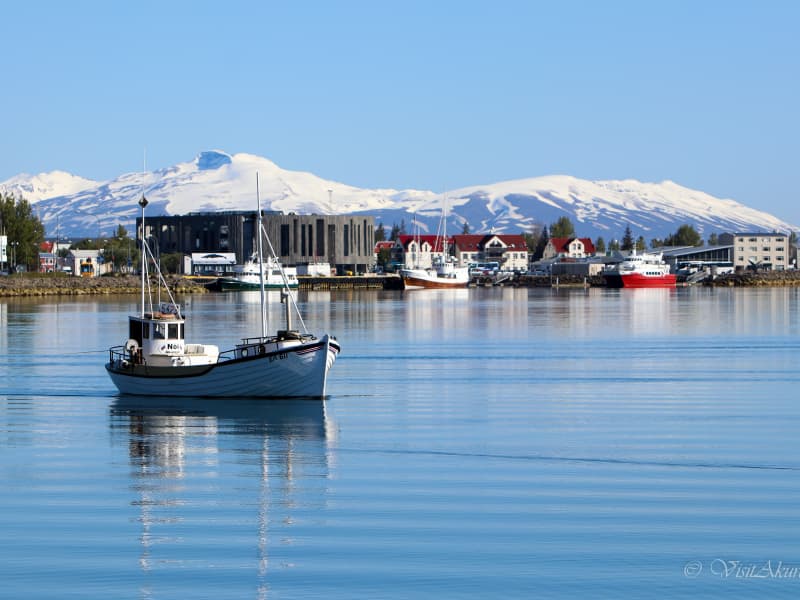
The Pond
The Pond in Akureyri is a fun outdoor recreation area in the heart of the town. In summer, it is buzzing with life when cruise ships start coming with guests from all over the world as well as small boats are fishing and sailing around. At the Pond, there is a variety of birdlife, the whales blow, and occasional seals can be seen.
View

Illugastaðir
At Illugastaðir on Vatnsnes peninsula you find one of the best seal watching place in Iceland. There are good facilities and service for travellers. Good walking path is next to the ocean and a trail to the sealwatching place. There you also find nice sealwatching hut to stay in when the weather is bad. The seals stays at Illugastaðir most days of the year, laying in rocks or swimming in the ocean close to the shore.
Good camping site is at Illugastaðir and perfect place for walking in the nature. All kind of bird do nest at Illugastaðir, and large numbers of Arctic tern and eider ducks.
Attention! Because of the large number of eider ducks that nest at Illugastaðir in the spring, the area is closed for all visitors from 1st of May until 20 June every year.
View
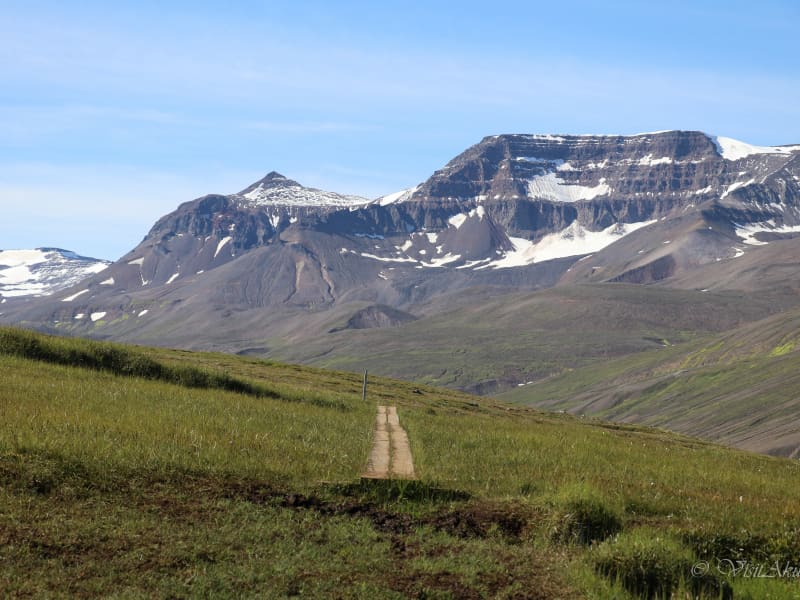
Glerá Canyons
Glerárgil has the deepest and most magnificent river gorges in Eyjafjörður but also one of the most vegetated. There are good walking paths along the gorge and there are about 8 bridges over the river, some for mixed traffic such as cars and pedestrians, while others are exclusively for bicycles and walking.
View

Ánastaðastapi Rock Formation
A sign "Ánastaðastapi" on road No. 711 indicates the parking area. Cross the stairs at the fence and take a short walk down the hill along a little creek to the shore. Here you find the beautiful sea stack Ánastaðastapi. Please be aware that this place is closed until July due to lambing season.
View
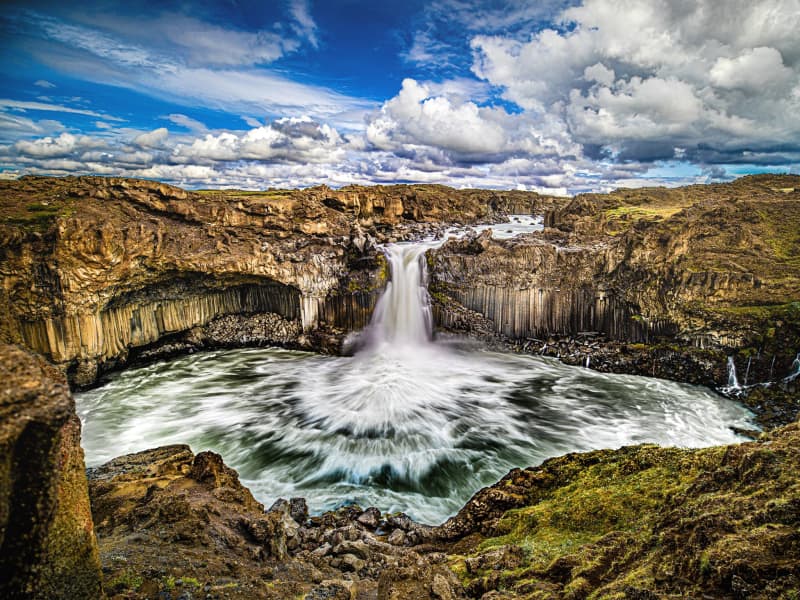
Aldeyjarfoss
Aldeyjarfoss waterfall is considered the most beautiful one in the river Skjalfandafljot. The waterfall is framed with long, natural basaltic columns. It is located in the uppermost regions of the Bardardalur valley, on the Sprengisandur highland route. It is possible to drive almost all the way up to it.
View

Selfoss waterfall
The waterfall Selfoss is in the river Jökulsá á Fjöllum and is only a few hundred meters south of Dettifoss waterfall. It is 10 meters high but very wide.
It is ideal to park in the car park by Dettifoss and take an easy walk to the two waterfalls. There are more beautiful natural phenomena in Jökulsárgljúfur canyon such as Hljóðaklettar and Hólmatungur.
View
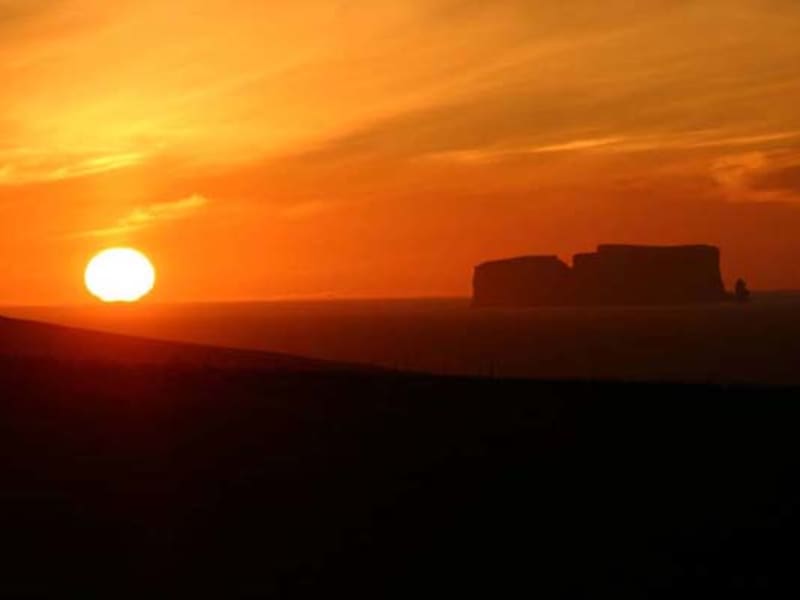
Drangey
The rocky island Drangey in the middle of Skagafjordur is a flat topped mass of tuff, rising almost 200 meters out of the ocean. The cliffs serve as nesting sites for around million sea birds and have been used throughout Iceland´s history for egg collection and bird netting.
Grettis Saga recounts that both Grettir and his brother Illugi lived on Drangey, for three years and were slain there. The island can only be ascended at one spot.During summer, Drangey Tours offers boat trips to the island.
View
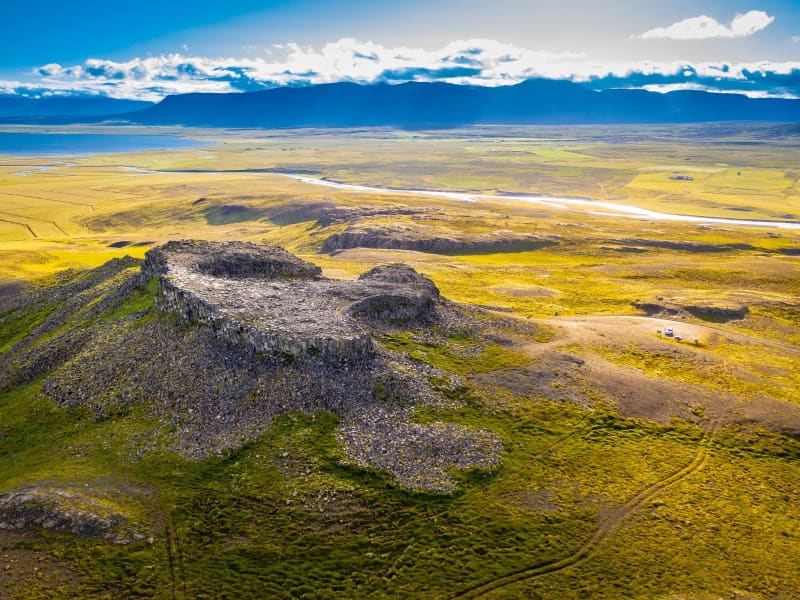
Borgarvirki
Borgarvirki is a 10-15 metre high ridge of columnar rock. This phenomenon is a volcanic plug, and there is speculation as to whether it was, in ancient times, a district fortress and even, perhaps, a battleground.From Borgarvirki there is a wide panoramic view over a large part of the region and a viewfinder is in place to help locate some of the important landmarks.This is truly a unique natural phenomenon, but one which has also seen some improvements by the hand of man in bygone days.
View
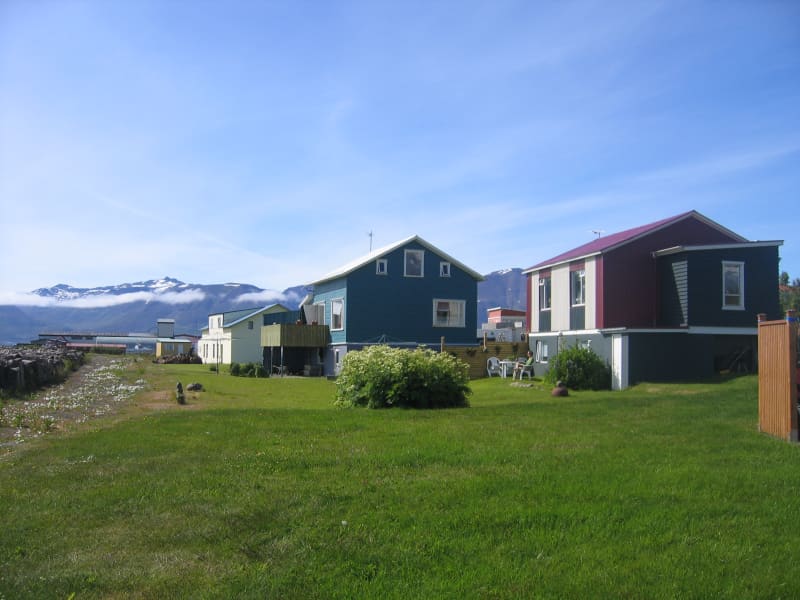
Hrísey
Hrísey is Iceland’s second largest island, the largest being Heimaey in the Westmann Islands. It is covered with vegetation, being, for the most part, flatland which only rises to 110 metres above sea level at its highest point. The bedrock is basalt, about 10 million years old. On the southernmost tip of the island is a small village where most of the islanders live. There is a relatively new swimming pool to tempt the visitor, and also the chance to do a spot of sightseeing from the trailer of a tractor, which is perhaps something one does not experience every day! The crossing between Hrísey and Árskógssandur takes about 15 minutes one way, and the ferry, Sævar, runs several times a day.
View
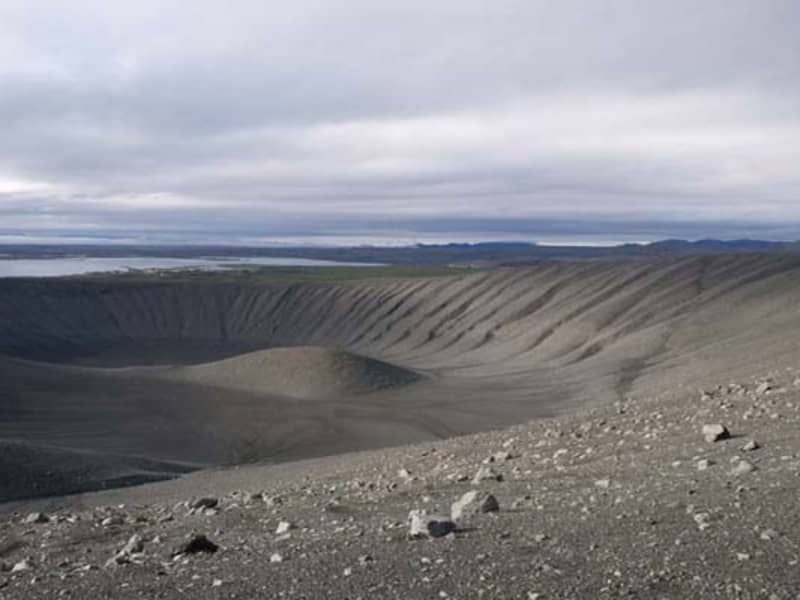
Hverfjall
Hverfjall has a large, circular explosion crater, about 140 metres deep and with a diameter of 1,000 metres. Hverfjall is one of Iceland's most beautiful and symmetrical explosion craters, besides being one of the largest of its kind in the world. It is estimated that the crater was created during a volcanic explosion and its likely around 2800 - 2900 years old.
View
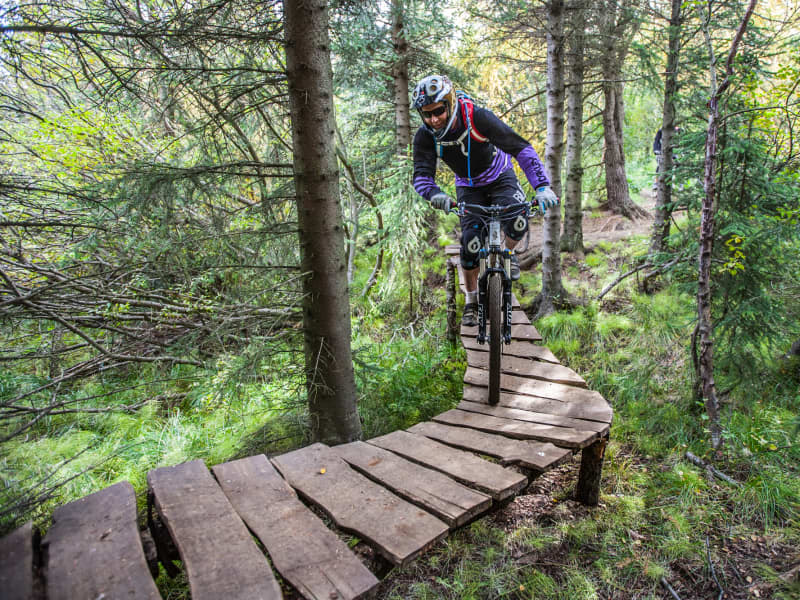
Kjarnaskógur woods
Kjarnaskógur Woods
South of Akureyri is one of the towns most popular outdoor area- the woodland Kjarnaskógur. The recreational area is approx 800hectars with more than 1.5 million trees, of many species planted within thelast 50 years. The area has diverse selection of trees and along the creekBrunná one can find a tree sample track. For bird lovers, the areais rich of birds and by the marshland in the north of the area (by Hundatjörnin Naustaborgir) there is a bird watching shelter. A campsite is nearby,Hamrar, with easy access to the forest.
In the forest you find:
* Three playgrounds * Volleyball courts and outdoor gym* Grill houses and pick-nick areas for both individuals and groups* Aprox. 12 km of gravel-tracks for hiking, running and biking, of which 6 kmare lighted during dark hours. Also plenty of forest tracks and other vastnetwork of back country trails. For more details view the maps further down thepage. * Restrooms and water fountain* 4 carparks* Mountain bike trails are in the woods and are also connected to the mountainbike trails in Mt. Hlíðarfjall - These combined create the longest mountainbike trail in Iceland with a total of 21.6 km.* During winter - the largest organized cross country tracks area (in awoodland area in Iceland) with around 20 km of groomed trails and 6km are lighted. The grooming statues can be viewed here. The colors onthe map indicate the time since they were groomed last (green, orange and pinkare from a couple of hours up to 48 hours, while light blue, dark blue and greyare from 2 days or up to 14 days or more). Areas for sledding are also groomedduring winter, by the statue of the Einar wood-ranger and below the sun-clock.
How to get there:Head south from the town along the road no. 823, pass the airport and turnright by the sign "Kjarnaskogur" and follow the bending road up tothe parking area. Aprox 5 min drive from town center and 30 minutes walk.It is possible to take bus number 1, 2 or 5 from town square,Ráðhústorg, and go out at Kjarnagata/Vallatún, by the golf course. From thereis about two km. walk to Kjarnaskógur area.
Contact info: Skógræktarfélag EyfirðingaSími: (+354) 462 4047Email: ingi@kjarnaskogur.isWebpage: https://www.kjarnaskogur.is/Map of the area: Kjarnaskógur - Easy and shorter walkshttps://www.visitakureyri.is/static/files/2012-VISIT/pdf/kjarnasogur-lettleidir-1-.pdfKjarnaskógur - All tails - overview map https://www.visitakureyri.is/static/files/2012-VISIT/pdf/kort-2018-stora-kortid-a-orva-a2.pdfHamrar - the campingsite and surroundingtrailshttps://www.visitakureyri.is/static/files/2012-VISIT/pdf/kort-2018-hamrar-lett-an-orva.pdfNaustaborgir - Naturereserve area -trails https://www.visitakureyri.is/static/files/2012-VISIT/pdf/kort-2018-naustaborgir-lett-an-orva.pdfGönguskíðabrautir - Crosscountrytrailshttps://www.visitakureyri.is/static/files/2012-VISIT/pdf/gonguskidi.pdf
View
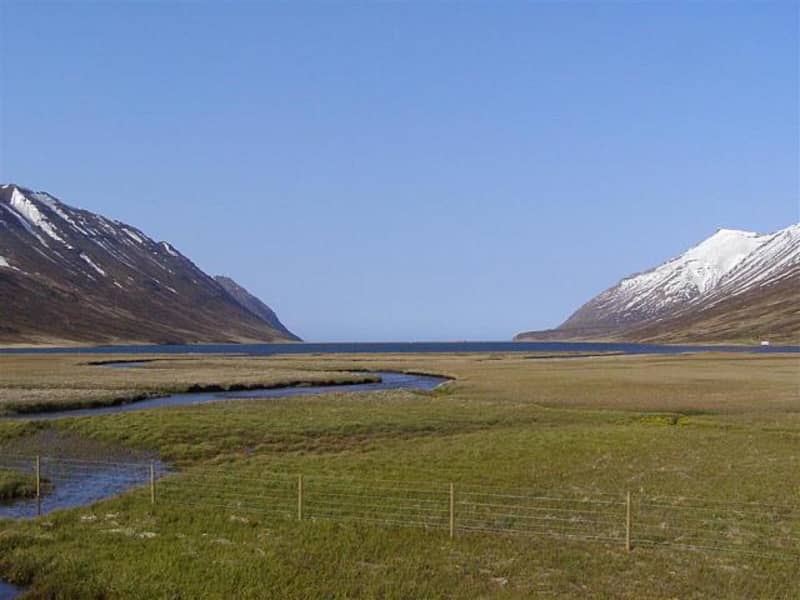
Héðinsfjörður
Héðinsfjörður is nearly 6 km long deserted northernmost fjord on the Tröllaskagi area. In the fjord is a good lake to catch fish, Héðinsfjarðarvatn, and the outlet from the Héðinsfjarðarós into the fjord. The next settlement to the west is the town Siglufjörður and to the east is Ólafsfjörður. Into the fjord lays beautiful valley, 5-6 km long. There is a large trout water, 1.7 square miles in size, that splendor the valley, 3 meters above sea level. There is a water trout and large seafish in water, about 1-5 lbs. The fish walks in the late summer.
A lot of wildlife is in the lake. The story says that the fox, who has visited some hunters unafraid and sought for a small fish. This water is not practiced much, yet it has their fans who seek peace and good fishing. Fishing hut is at the northern end of the lake.
Enough entertainment is on Tröllaskagi and nearest area, whether it is winter or summer, for example; skiing, snowmobile, sea angling, golfing, soccer, hiking, horseback riding, fishing, museums and much more.
View
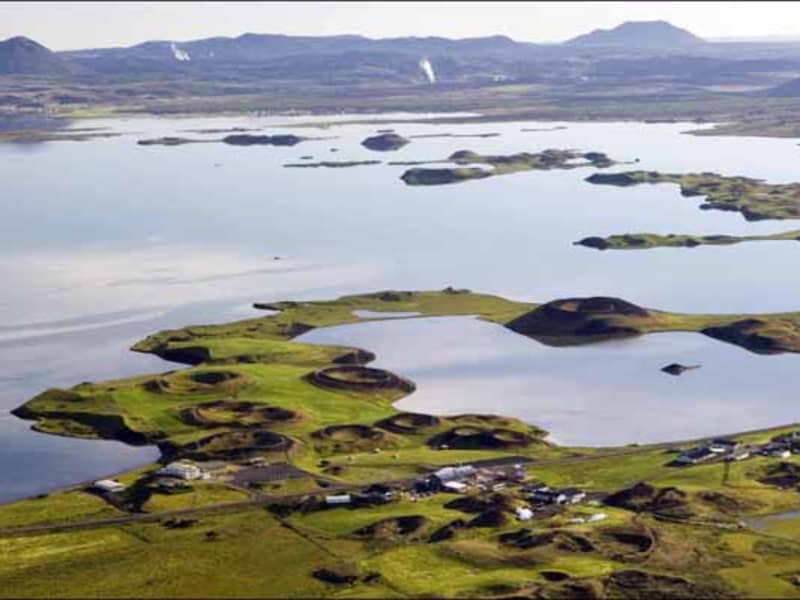
Lake Mývatn
Mývatn is the 4th largest lake in Iceland, 37 km2 in area. Its shores are indented with many coves and inlets and its surface is dotted with around 50 small islets and skerries. Midges (Chironomidae) are abundant and the ubiquitous swarms of these tiny flies give the Lake its name.The lake itself is very shallow, and the rays of the sun reach the lake bed over its entire surface. The ecology of the lake area is extremely diverse and interesting; one important characteristic of Mývatn, being the prolific growth and abundance of freshwater seaweed. On the bed of the lake are great quantities of diatoms, while, nearer the surface, Mývatn’s famous arctic char weave their way between aquatic plants and little islets topped with fertile vegetation. On and around the lake there is a teeming and varied birdlife, and Mývatn is the habitat of many kinds of lake and marsh birds. However, much of Mývatn’s fame is due to the fact that, during summer, there are more different species of duck gathered on and around the lake than anywhere else in the world. Mývatn is a legally protected conservation area and appears on the register of internationally important wetlands, along with the Laxá river which flows out of the lake.
View

Víti
Víti is a huge explosion crater, about 300 metres in diameter. The crater was formed during a massive volcanic eruption at the start of the famous Mývatn Fires in 1724. The eruption continued more or less non-stop for 5 years and Víti's bubbling cauldron of mud boiled for more than a century after that. Víti is situated near Krafla and there is a tarmacked road leading up to it from highway 1.
View
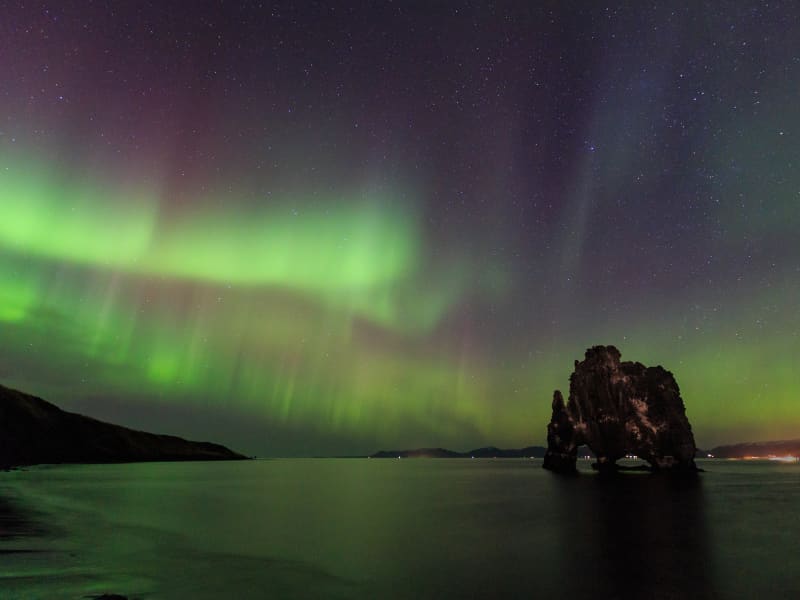
Hvítserkur
Hvítserkur is a 15 m-high sea stack just off shore on the eastern side of Vatnsnes. Good seal spotting place at the estuary of the Sigridarstadir lake, south from the stack.
View

Raudanes peninsula
Rauðanes peninsula in Þistilfjörður is another example of exceptional natural beauty. There is a marked path which takes you along a circular route of about 7 km of easy walking. Heather moorland is the predominant type of vegetation, although there is also a fair amount of grassland. At the start of the walk, you will pass Háabjarg, a rocky outcrop 60 metres in height, whose layers of rock, built up over the centuries, are easily apparent. The extensive views from the peninsula are not to be missed.
View
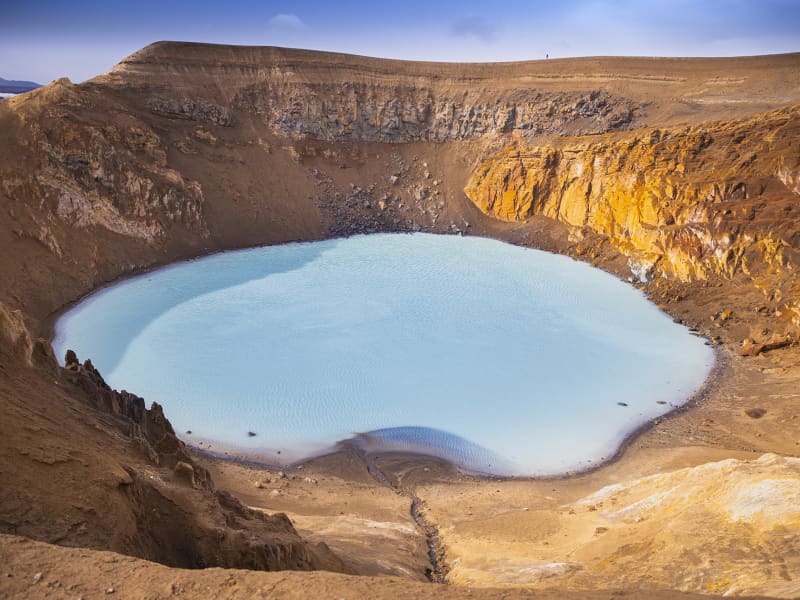
Askja
Askja is a 50 km2 caldera in the Dyngjufjoll mountains. The mountains emerged in eruptions under an Ice Age glacier cap. Askja itself was formed, for the most part, at the end of the Ice Age in a major ash eruption which caused the roof of the magma chamber at the heart of the central volcano to subside.
Askja is a part of Vatnajökull National Park.
The caldera contains several volcanoes, including Víti (explosive volcanic crater). Water has accumulated in the crater, its temperature is variable - it is around 30°C on average. Víti is a popular bathing site, but if you intend taking a dip, please be aware that the sloping path is very slippery in wet weather.
The road to Askja goes from road 1 to road 901 and onto mountain road F905. Onward to F910 to Drekagil. On this route there are two fords to cross, usually small. From Drekagil goes mountain road F894 (8 km) to the car park at Vikraborgir.Another option is to go from road 1 to mountain road F88 via Herðubreiðarlindir to Drekagil. On this road ther are fords on the rivers Grafarlandsá and Lindá that need to be crossed. The fords can be difficult or even impassable for small jeeps.
View
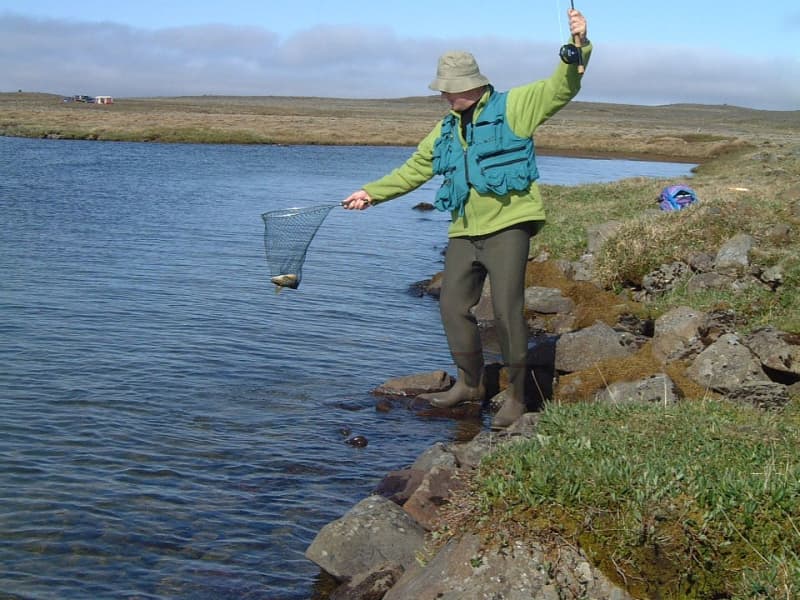
Arnarvatnsheiði
“Eagle Lake moors” is a larg green, lake-studded landscape in the highland, south of Húnaflói. The area extends for 80km or so south to the glaciers of Eiriksjokul and Langjokul. It´s a popular trout fishing venue in a wild, lonely nature. 4WD track.
View
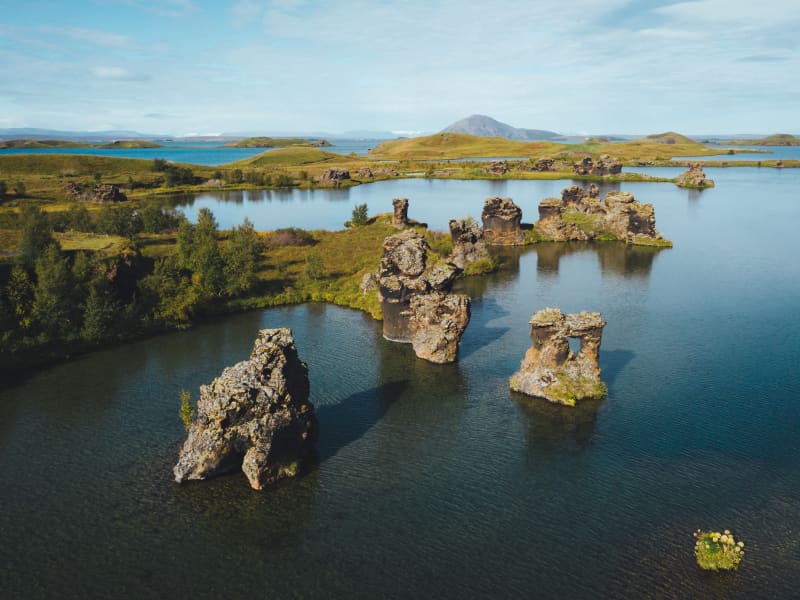
Höfði
Höfði is a rocky promontory which reaches into the waters of Lake Mývatn. The view from here is good, giving a vista of the lake's coves and inlets, besides being an excellent site for bird watching. Kálfastrandarvogur bay laps the shores of Höfði and is famous for its unusual lava formations both off and onshore and these rocky outcrops, named Klasar and Kálfastrandarstrípar, have done much to earn Kálfastrandarvogur and Höfði their reputation for being among the most beautiful areas around Mývatn.
View
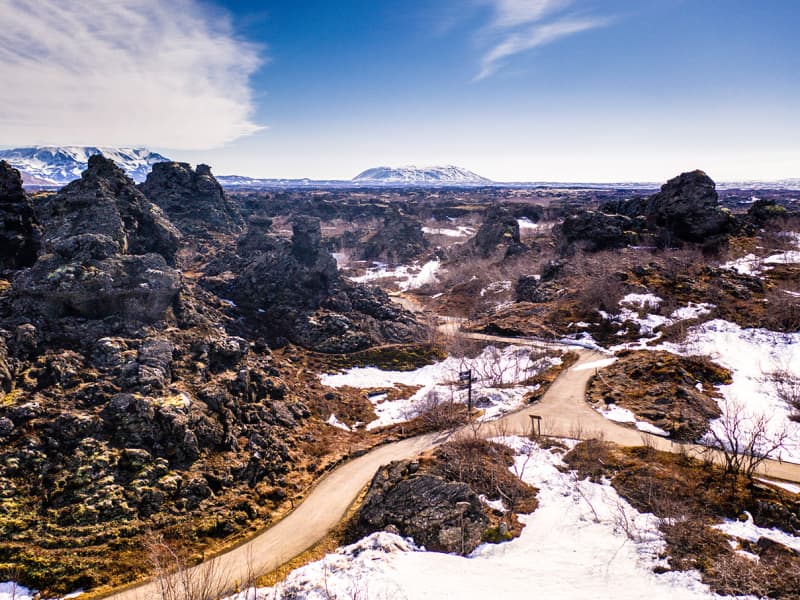
Dimmuborgir
Dimmuborgir or Dark Cities is an area of randomly strewn lava rocks and cliffs, surrounded by vegetation such as low bushes and plants. Dimmuborgir is a place of surprises with its myriad forms and images, small caves and towering volcanic rock, pierced by natural apertures.
The most famous of these formations is the cave "The Church", aptly named for its dome-like ceiling.
It is not only in summer that Dimmuborgir exerts its charm; a winter visit is also an invigorating experience which must include popping in to see the Yule Lads (Santas) who have settled there and made it their home.
View
